Material flow accounts statistics - material footprints
Data from February 2024
Planned article update: 15 October 2024
Highlights
EU's material footprint amounted to 14.9 tonnes per capita in 2022.

Source: Eurostat (env_ac_rme) (env_ac_mfa)
This article presents the material footprints of European countries and the European Union (EU). Material footprints quantify the worldwide demand for material extractions (biomass, metal ores, non-metallic minerals and fossil energy materials/carriers) triggered by consumption and investment by households, governments and businesses in European countries and the EU, respectively.
Material footprints are estimated, using data from national accounts and material flow accounts. The latter are presented in more detail in the article 'material flow accounts and resource productivity'. Other articles related to material flows discuss resource productivity statistics and physical imports and exports. The modelling estimates presented in this article have a higher statistical uncertainty.
Full article
EU's material footprint by material category over time
Raw material consumption (RMC) of the EU – also referred to as material footprint – represents the total amount of extracted raw materials needed to produce the goods and services consumed by residents of the EU.
Figure 1 shows the development of the EU's material footprint or raw material consumption (RMC) over time. With around 18 tonnes per capita, the RMC peaked in the period 2007/2008 just before the global financial crisis. The latter induced a significant drop to a level of around 14 tonnes per capita around the years 2013-2016. Since then, RMC shows a slightly increasing trend leading to 14.9 tonnes per capita in 2022, corresponding to approximately 6.6 billion tonnes.
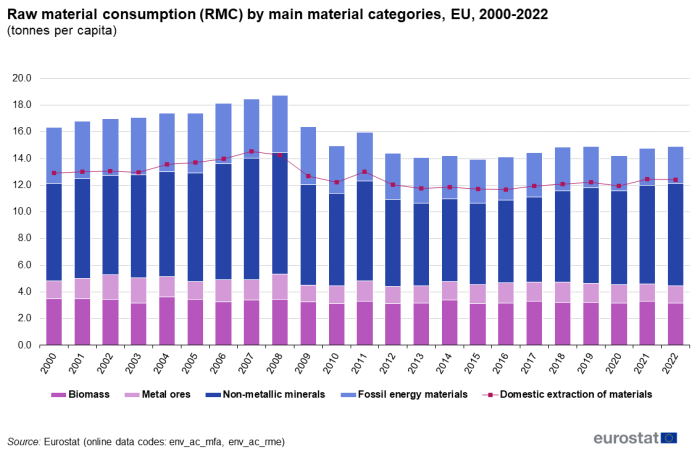
Source: Eurostat (env_ac_rme) (env_ac_mfa)
Figure 1 also shows the EU's material footprint (RMC) in a breakdown by four main material categories. Non-metallic minerals is the largest material category, the development of which is highly determined by the activity level of the EU's construction industries. Among the four material categories, RMC of fossil energy materials has been steadily decreasing by about 1 % each year.
For comparison, Figure 1 includes the development of another important material flow indicator as a dotted line: domestic extraction (DE), which takes into account those materials extracted from the EU territory. For the EU, both indicators show a similar development, whereby the difference between RMC and DE shows a decreasing trend. In 2022, it was 2.5 tonnes per capita. The maximum difference was in 2008 with 4.5 tonnes per capita.
Material footprint of European countries
Figure 2 presents material footprints or raw material consumption (RMC) for European countries. In 2022, nine countries remained below the EU value of 14.9 tonnes per capita. In 20 countries, the material footprint per capita was higher than the EU value.
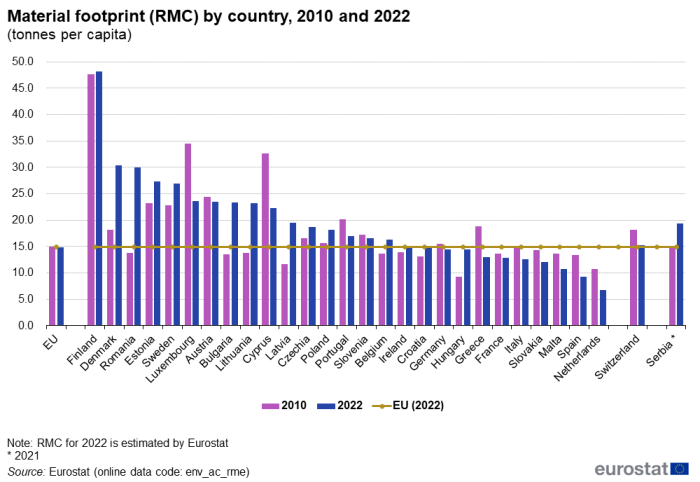
Source: Eurostat (env_ac_rme)
The spread between the highest and lowest footprint was rather high with more than 40 tonnes. Finland, Denmark and Romania had the highest material footprints with around 30-48 tonnes per capita. The Netherlands has the lowest footprint with 6.8 tonnes per capita.
The development of RMC per capita for the individual countries shows a diverse picture. Compared with 2010, 14 countries had managed to reduce their material footprints over the years - of which five countries had reduced their material footprint by more than a quarter. Fourteen European countries had seen an increase in RMC per capita. Romania's footprint more than doubled over the years in contrast to the Netherlands, where it decreased by more than a third. Most Mediterranean countries had a lower material footprint in 2022 than in 2010. The material footprints of Finland, Slovenia and Austria were more or less on the same level as one decade ago.
EU's material footprint vis-a-vis the rest of the world
Table 1 provides an overview of the material extraction and consumption in the EU vis-a-vis the rest of the world. For 2021, the worldwide material extraction was estimated at ca. 97.5 billion tonnes, of which 5.6 billion tonnes were extracted in the EU (representing 5.7 % of worldwide material extraction). Approximately 1.3 billion tonnes of the EU material extraction served consumption in the rest of the world. The material footprint (RMC), that is all materials serving the EU's consumption, was estimated at 6.6 billion tonnes, representing 6.8 % of worldwide material extraction. The material footprint of the EU's consumption was composed of two parts: domestic material extraction (4.2 billion tonnes) and materials extracted outside the EU (2.4 billion tonnes).
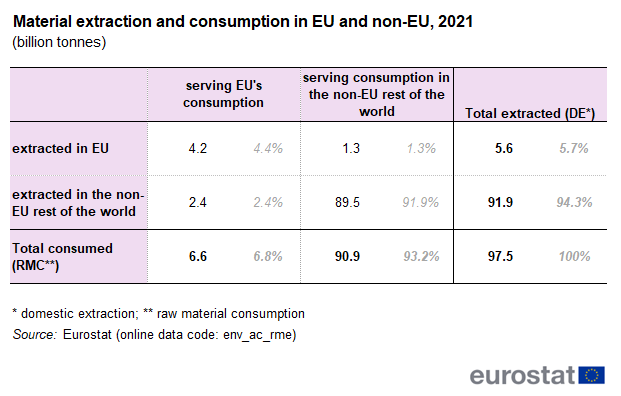
Source: Eurostat (env_ac_rme), www.materialflows.net
Raw material consumption by final use of products
The indicator RMC gives insight into the quantity and type of materials required to meet the EU's demand for final use of products. It can be further broken down by product and by type of final use to analyse which specific products and final uses drive material extraction.
Figure 3 presents the RMC in a breakdown by main material category and by the two main types of domestic final use; namely, final consumption expenditure and gross capital formation (note: the term 'final use' indicates that intermediate consumption is excluded). Overall, 54 % of RMC was due to consumption expenditure, and thus 46 % of RMC was due to gross capital formation in 2021. Gross capital formation in the form of investments in construction is an important driver of the extraction of non-metallic minerals. RMC of biomass and fossil energy materials is mainly driven by consumption expenditure.
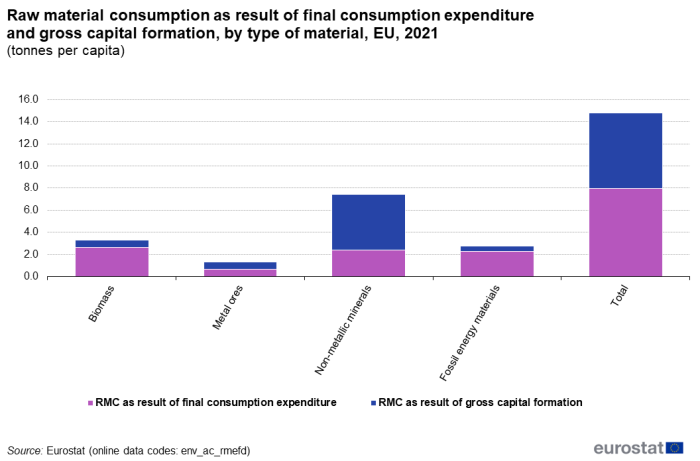
Source: Eurostat (env_ac_rmefd)
Table 2 shows in more detail which product groups are the main drivers of material extraction. One can clearly see the large impact of the product group 'Constructions and construction works' on the EU's material footprint.
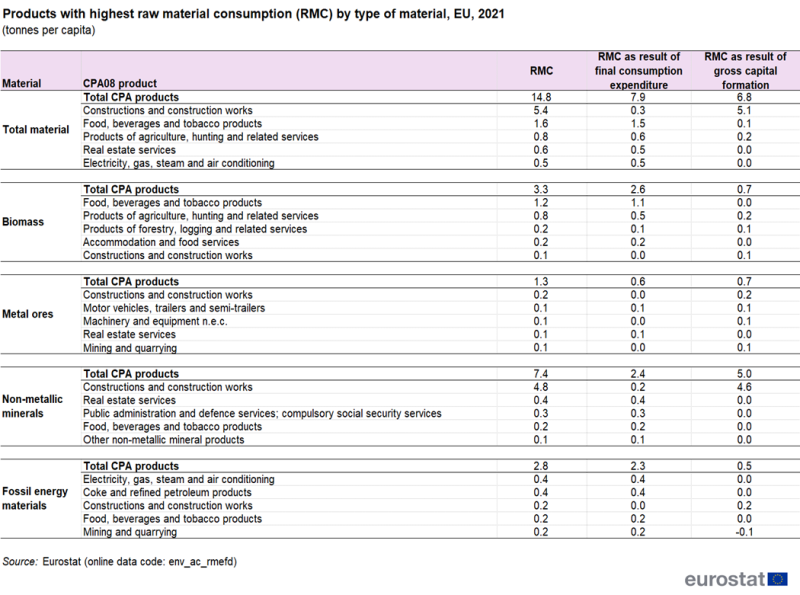
Source: Eurostat (env_ac_rmefd)
Source data for tables and graphs
Data sources
Domestic extraction and raw material consumption (RMC), also referred to as 'material footprint', are material flow indicators.
Domestic extraction is recorded in economy-wide material flow accounts (EW-MFA) and represents the physical amount of materials extracted from the environment by a national economy. Eurostat collects EW-MFA from the national statistical institutes (NSI) under Regulation (EU) No 691/2011 on European environmental-economic accounts. For more details on the material flow accounts data collection, see the reference metadata of the EW-MFA.
EW-MFA are in turn a subset of the European environmental-economic accounts. Environmental accounts can be used to analyse the interaction between the environment and the economy, because the accounts organise environmental information in a way that is consistent with the accounting principles of national accounts. The environmental accounts methodology is in line with the System of Environmental-Economic Accounting (SEEA), which is an international statistical standard.
Raw material consumption (RMC) quantifies the worldwide demand for material extractions - also referred to as raw material equivalents (RME) - triggered by consumption and investments of a given economy.
In accordance with national accounts' concepts, the RMC is considered as the material extractions induced worldwide for providing products to the domestic final use of a given economy. The latter is a common concept in national accounts and includes final consumption and investments (capital). Final consumption expenditure includes consumption expenditure by households, government and non-profit institutes serving households. Gross capital formation includes investments, both in fixed assets as well as changes in inventories and valuables. Economic modelling enables this re-attribution of material extraction to the domestic final use of products.
Basic concepts used in national accounting are further explained in the Statistics Explained article 'Building the System of National Accounts - basic concepts' from the online publication 'Building the System of National Accounts'. Another good introduction in national accounting is the OECD publication 'Understanding National Accounts'.
To estimate RMC and other indicators expressed in raw material equivalents (RME), Eurostat Eurostat employs an environmentally-extended hybrid input-output model for the aggregated EU economy for more details see the documentation of the EU RME model).
As regards estimates at country level, Eurostat supports statistical bodies by offering the so-called Country-RME-tool. This tool builds on average factors derived from the EU-RME-model. Both models are presented in more detail in the Country RME tool Handbook and the Documentation of the EU-RME-model. National statistical institutes are also free to develop and use their own estimation models. Eurostat collects material flow indicators in raw material equivalents (RME) from national statistical institutes on a voluntary basis, with around 15 countries reporting so far. Eurostat produces and disseminates estimates for those EU Member States that do not report their own estimates (see Country RME tool Handbook).
The modelling that is required for estimating RMC and other indicators expressed in RME leads to higher uncertainty of the data.
Eurostat disseminates two data sets:
(1) The data set 'Material flow accounts in raw material equivalents' (env_ac_rme) includes a breakdown by four main material categories; biomass, metal ores, non-metallic minerals, and fossil energy materials/carriers, each with several more detailed breakdowns, with a total of 67 categories (including grouped categories).
(2) The data set 'Material flow accounts in raw material equivalents by final uses of products' (env_ac_rmefd) presents data for the aggregated EU economy on raw material consumption, by material category, product and final use type.
Context
Material flow accounts in raw material equivalents are part of environmental accounts. The latter enable the assessment of the interplay between the economy and the environment, which in turn provides relevant information to see whether current production and consumption activities are sustainable. The raw material consumption (RMC) – also referred to as 'material footprint' – is an indicator proposed to monitor sustainable development. The EU’s Eighth Environment Action Programme aims to significantly decrease the EU’s material footprint.
Direct access to
- Material flow accounts in raw material equivalents - modelling estimates (env_ac_rme) - data browser
- Material flow accounts in raw material equivalents by final uses of products - modelling estimates (env_ac_rmefd) - data browser
- Material flow accounts (env_ac_mfa) - data browser
- Circular economy, see:
- Circular economy indicators (cei)
- Documentation of the EU RME model, February 2024
- Economy-wide material flow accounts handbook - 2018 version
- Environment - Methodology page see: 'Material flows and resource productivity' or 'Input-output modelling and tools'